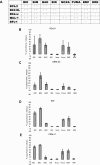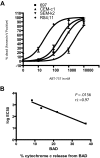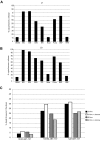BCL-2 dependence and ABT-737 sensitivity in acute lymphoblastic leukemia
- PMID: 18056841
- PMCID: PMC2234061
- DOI: 10.1182/blood-2007-06-098012
BCL-2 dependence and ABT-737 sensitivity in acute lymphoblastic leukemia
Abstract
Cancer cells acquire disruptions in normal signal transduction pathways and homeostatic mechanisms that would trigger apoptosis in normal cells. These abnormalities include genomic instability, oncogene activation, and growth factor independent proliferation. Therefore, cancer cells likely require a block in apoptosis in order to survive. Overexpression of the antiapoptotic protein BCL-2 provides a block in apoptosis that is frequently observed in cancer cells. We have developed methods for the detection and analysis of BCL-2 dependence and here apply them to acute lymphoblastic leukemia (ALL). BH3 profiling, a mitochondrial assay that classifies blocks in the intrinsic apoptotic pathway, indicated a dependence on BCL-2 of both ALL cell lines and primary samples. This dependence predicted that BCL-2 would be complexed with select pro-death BH3 family proteins, a prediction confirmed by the isolation of BCL-2 complexes with BIM. Furthermore, the BH3 profiling and protein analysis predicted that ALL cell lines and primary cells would be sensitive to ABT-737 as a single agent. Finally, BH3 profiling and protein studies accurately predicted a relative degree of sensitivity to BCL-2 antagonism in cell lines. The ALL cells studied exhibit BCL-2 dependence, supporting clinical trials of BCL-2 antagonists in ALL as single agents or combination therapies.
Figures






Similar articles
-
BH3 profiling--measuring integrated function of the mitochondrial apoptotic pathway to predict cell fate decisions.Cancer Lett. 2013 May 28;332(2):202-5. doi: 10.1016/j.canlet.2011.12.021. Epub 2012 Jan 8. Cancer Lett. 2013. PMID: 22230093 Free PMC article. Review.
-
Chronic lymphocytic leukemia requires BCL2 to sequester prodeath BIM, explaining sensitivity to BCL2 antagonist ABT-737.J Clin Invest. 2007 Jan;117(1):112-21. doi: 10.1172/JCI28281. J Clin Invest. 2007. PMID: 17200714 Free PMC article.
-
BH3 profiling identifies three distinct classes of apoptotic blocks to predict response to ABT-737 and conventional chemotherapeutic agents.Cancer Cell. 2007 Aug;12(2):171-85. doi: 10.1016/j.ccr.2007.07.001. Cancer Cell. 2007. PMID: 17692808
-
Co-targeting of Bcl-2 and mTOR pathway triggers synergistic apoptosis in BH3 mimetics resistant acute lymphoblastic leukemia.Oncotarget. 2015 Oct 13;6(31):32089-103. doi: 10.18632/oncotarget.5156. Oncotarget. 2015. PMID: 26392332 Free PMC article.
-
Small molecule inhibition of the Bcl-X(L)-BH3 protein-protein interaction: proof-of-concept of an in vivo chemopotentiator ABT-737.Curr Top Med Chem. 2007;7(10):961-5. doi: 10.2174/156802607780906843. Curr Top Med Chem. 2007. PMID: 17508927 Review.
Cited by
-
BH3 profiling--measuring integrated function of the mitochondrial apoptotic pathway to predict cell fate decisions.Cancer Lett. 2013 May 28;332(2):202-5. doi: 10.1016/j.canlet.2011.12.021. Epub 2012 Jan 8. Cancer Lett. 2013. PMID: 22230093 Free PMC article. Review.
-
Small-molecule Bcl-2 antagonists as targeted therapy in oncology.Curr Oncol. 2008 Dec;15(6):256-61. doi: 10.3747/co.v15i6.392. Curr Oncol. 2008. PMID: 19079626 Free PMC article.
-
Advances in targeted therapy for malignant lymphoma.Signal Transduct Target Ther. 2020 Mar 6;5(1):15. doi: 10.1038/s41392-020-0113-2. Signal Transduct Target Ther. 2020. PMID: 32296035 Free PMC article. Review.
-
One-Two Punch Therapy for the Treatment of T-Cell Malignancies Involving p53-Dependent Cellular Senescence.Oxid Med Cell Longev. 2021 Sep 21;2021:5529518. doi: 10.1155/2021/5529518. eCollection 2021. Oxid Med Cell Longev. 2021. PMID: 34603598 Free PMC article.
-
ABT-737 synergizes with bortezomib to induce apoptosis, mediated by Bid cleavage, Bax activation, and mitochondrial dysfunction in an Akt-dependent context in malignant human glioma cell lines.J Pharmacol Exp Ther. 2012 Jun;341(3):859-72. doi: 10.1124/jpet.112.191536. Epub 2012 Mar 5. J Pharmacol Exp Ther. 2012. PMID: 22393246 Free PMC article.
References
-
- Pui CH, Jeha S. New therapeutic strategies for the treatment of acute lymphoblastic leukaemia. Nat Rev Drug Discov. 2007;6:149–165. - PubMed
-
- Thomas DA, Cortes J, Kantarjian HM. New agents in the treatment of acute lymphocytic leukaemia. Best Pract Res Clin Haematol. 2002;15:771–790. - PubMed
-
- Hahn WC, Weinberg RA. Modelling the molecular circuitry of cancer. Nat Rev Cancer. 2002;2:331–341. - PubMed
-
- Green DR, Evan GI. A matter of life and death. Cancer Cell. 2002;1:19–30. - PubMed
-
- Danial NN, Korsmeyer SJ. Cell death: critical control points. Cell. 2004;116:205–219. - PubMed
Publication types
MeSH terms
Substances
Grants and funding
LinkOut - more resources
Full Text Sources
Other Literature Sources

